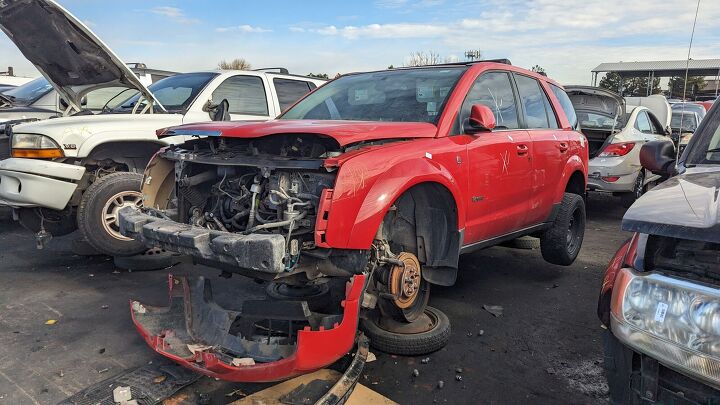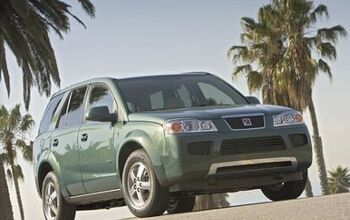Junkyard Find: 2007 Saturn Vue Green Line

Honda beat everybody to the production gasoline-electric hybrid game in the United States, putting the Insight in showrooms in 1999. Toyota followed with the Prius a year later, but it took GM until 2006 to introduce its first true gasoline-electric hybrid here. That car was the 2007 Saturn Vue Green Line, and I managed to find one in a Denver-area car graveyard recently.
Our nameless reviewer felt, back in 2006, that the Vue's panel gaps made it the "automotive equivalent of a shotgun shack" and calculated that the Green Line version would require 90,000 miles of driving with $2.15/gallon gas in order to recoup its cost over the pure-gazzoline version. In fact, fuel prices went insane right around the time that review was written.
If we look at the fine print, GM actually introduced a sort-of-a-hybrid vehicle as a 2004 model, though the 2004 Chevrolet Silverado Hybrid/GMC Sierra Hybrid didn't have regenerative braking.
Ford launched the Escape Hybrid as a 2005 model (its Mercury Mariner and Mazda Tribute siblings showed up a bit later), so The General had some catching up to do in the green-car department. Nissan introduced the Altima Hybrid as a 2007 model (and using licensed Toyota hardware), though it disappeared quickly and without leaving much trace.
Toyota and Honda didn't have much to fear from the Vue Green Line's hybrid technology, but it did benefit from regenerative braking and delivered a pretty good 23 city/29 highway miles per gallon (versus 19/25 mpg for the base Vue with 2.2-liter engine and automatic).
The system replaced the starter motor and alternator with a belt-driven motor/generator rig that generated five horsepower and 48 pound-feet. A 2.4-liter Ecotec gas-burner did most of the work with its 170 horsepower.
You could get a manual transmission in the regular Vue, but the Green Line was slushbox-only.
The green paint has faded from this Green Line badge, but it was supposed to be the Gaia-loving counterpart to the planet-ravaging Saturn Ion Red Line. I have mounted Red Line and Green Line badges side-by-side on my garage wall, in order to represent the duality of man.
The storm clouds over General Motors were getting darker by the minute when this car was built, and Saturn would soon have its head on the chopping block. Geo and Oldsmobile were already gone, with Pontiac and Saturn following in 2010.
The entry-level '07 Vue started at $17,995 (about $27,588 in 2024 dollars), while the Green Line version had an MSRP of $22,995 ($35,254 after inflation). Even with $4/gallon gas ($6.13 gallon in today's money), it would have taken quite a while to break even with the Green Line.
The Vue's platform outlived Saturn and still lives today, though. You'll find its derivatives underpinning everything from the Suzuki XL7 to the Wuling Almaz, and it all began with the 2002 Vue.
The interior isn't bad, but a 17-year-old non-AWD car made by a long-defunct brand doesn't command much resale value these days.
There is a way to recapture the world's imagination. To stay the same in one way, and evolve in another. Chapter 11 bankruptcy was approaching quickly, by the way.
A 2007 Saturn Vue Green Line hybrid in a Colorado wrecking yard.
A 2007 Saturn Vue Green Line hybrid in a Colorado wrecking yard.
A 2007 Saturn Vue Green Line hybrid in a Colorado wrecking yard.
A 2007 Saturn Vue Green Line hybrid in a Colorado wrecking yard.
A 2007 Saturn Vue Green Line hybrid in a Colorado wrecking yard.
A 2007 Saturn Vue Green Line hybrid in a Colorado wrecking yard.
A 2007 Saturn Vue Green Line hybrid in a Colorado wrecking yard.
A 2007 Saturn Vue Green Line hybrid in a Colorado wrecking yard.
A 2007 Saturn Vue Green Line hybrid in a Colorado wrecking yard.
[Images: The Author]
Become a TTAC insider. Get the latest news, features, TTAC takes, and everything else that gets to the truth about cars first by subscribing to our newsletter.

Murilee Martin is the pen name of Phil Greden, a writer who has lived in Minnesota, California, Georgia and (now) Colorado. He has toiled at copywriting, technical writing, junkmail writing, fiction writing and now automotive writing. He has owned many terrible vehicles and some good ones. He spends a great deal of time in self-service junkyards. These days, he writes for publications including Autoweek, Autoblog, Hagerty, The Truth About Cars and Capital One.
More by Murilee Martin
Latest Car Reviews
Read moreLatest Product Reviews
Read moreRecent Comments
- Tassos Under incompetent, affirmative action hire Mary Barra, GM has been shooting itself in the foot on a daily basis.Whether the Malibu cancellation has been one of these shootings is NOT obvious at all.GM should be run as a PROFITABLE BUSINESS and NOT as an outfit that satisfies everybody and his mother in law's pet preferences.IF the Malibu was UNPROFITABLE, it SHOULD be canceled.More generally, if its SEGMENT is Unprofitable, and HALF the makers cancel their midsize sedans, not only will it lead to the SURVIVAL OF THE FITTEST ones, but the survivors will obviously be more profitable if the LOSERS were kept being produced and the SMALL PIE of midsize sedans would yield slim pickings for every participant.SO NO, I APPROVE of the demise of the unprofitable Malibu, and hope Nissan does the same to the Altima, Hyundai with the SOnata, Mazda with the Mazda 6, and as many others as it takes to make the REMAINING players, like the Excellent, sporty Accord and the Bulletproof Reliable, cheap to maintain CAMRY, more profitable and affordable.
- GregLocock Car companies can only really sell cars that people who are new car buyers will pay a profitable price for. As it turns out fewer and fewer new car buyers want sedans. Large sedans can be nice to drive, certainly, but the number of new car buyers (the only ones that matter in this discussion) are prepared to sacrifice steering and handling for more obvious things like passenger and cargo space, or even some attempt at off roading. We know US new car buyers don't really care about handling because they fell for FWD in large cars.
- Slavuta Why is everybody sweating? Like sedans? - go buy one. Better - 2. Let CRV/RAV rust on the dealer lot. I have 3 sedans on the driveway. My neighbor - 2. Neighbors on each of our other side - 8 SUVs.
- Theflyersfan With sedans, especially, I wonder how many of those sales are to rental fleets. With the exception of the Civic and Accord, there are still rows of sedans mixed in with the RAV4s at every airport rental lot. I doubt the breakdown in sales is publicly published, so who knows... GM isn't out of the sedan business - Cadillac exists and I can't believe I'm typing this but they are actually decent - and I think they are making a huge mistake, especially if there's an extended oil price hike (cough...Iran...cough) and people want smaller and hybrids. But if one is only tied to the quarterly shareholder reports and not trends and the big picture, bad decisions like this get made.
- Wjtinfwb Not proud of what Stellantis is rolling out?





















































Comments
Join the conversation
I'll say one thing about those plastic bodies: they still look good after a decade and a half. Automakers should be sheathing their cars in petroleum-based plastic before they thin out the "sheet metal" to foil thickness.
There’s one of these around the corner from me. It still runs…driven daily, in fact. That fact always surprises me.